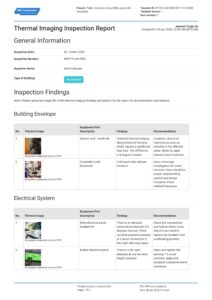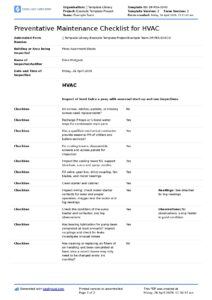In the complex world of electrical maintenance, identifying potential issues before they escalate into costly failures or safety hazards is paramount. This is where electrical thermal imaging truly shines, offering a non-invasive way to detect abnormal heat patterns that often indicate underlying problems like loose connections, imbalanced loads, or faulty components. It’s like having X-ray vision for your electrical systems, revealing hidden dangers that are invisible to the naked eye.
However, capturing thermal images is only half the battle. The real value comes from interpreting that data and communicating it effectively to those who need to act on it. A well-structured report transforms raw thermal data into actionable insights, providing a clear roadmap for repairs, maintenance, and system upgrades. Without a comprehensive and understandable report, even the most advanced thermal scan might go unutilized, leaving your electrical infrastructure vulnerable.

That’s why having a robust electrical thermal imaging report template isn’t just a convenience; it’s a critical tool for any professional conducting these inspections. It ensures consistency, clarity, and completeness, helping to standardize your findings and recommendations. A good template streamlines the reporting process, saves time, and most importantly, ensures that vital information isn’t overlooked, leading to more efficient and safer electrical operations.
What Makes an Effective Electrical Thermal Imaging Report Template?
An effective electrical thermal imaging report template is more than just a blank document; it’s a structured framework that guides the inspector through every crucial step of documenting their findings. It ensures that all necessary information is captured, presented clearly, and is easily understood by both technical personnel and management. The goal is to move from detection to resolution as smoothly as possible, and a well-designed template is the linchpin of this process. It removes ambiguity and provides a consistent narrative for all inspections, regardless of who performs them.
Key Sections for Clarity and Action
Every professional report should begin with essential administrative and summary details, setting the stage for the technical content that follows. This ensures the report is properly contextualized for the client and stakeholders.
- Executive Summary: This vital section provides a high-level overview of the inspection’s purpose, key findings, and main recommendations. It’s often the first, and sometimes only, section busy managers read, so it must be concise and impactful.
- Client and Site Information: Details like client name, site address, date of inspection, and report number are fundamental for proper record-keeping and referencing. It clearly identifies where and when the inspection took place.
- Equipment Details: A thorough listing of all inspected electrical equipment, including panel numbers, circuit descriptions, and asset tags, ensures specificity and helps in tracking individual component health over time.
- Inspection Scope and Methodology: Describing the standards followed, the equipment used (e.g., specific thermal camera model), and the environmental conditions during the inspection adds credibility and transparency to the process.
Detailed Findings and Visual Evidence
The core of any thermal imaging report lies in its detailed findings, supported by compelling visual evidence. This is where the abnormalities are identified, quantified, and explained, providing irrefutable proof of the electrical issues at hand.
- Anomalies Detected: This section lists each specific anomaly found, detailing its exact location, the component affected, ambient temperature, and critical temperature readings (e.g., maximum temperature, delta T from a healthy component or phase).
- Thermal Images: High-quality thermal images are crucial. Each anomaly should be accompanied by both a thermal image and a corresponding visible light (digital) photograph of the same area. These images should be clearly labeled, include temperature scales, and ideally have measurement points or boxes indicating the hottest spots.
- Severity Assessment: Classifying the urgency of each finding (e.g., Critical, Serious, Moderate, Minor) helps prioritize repairs. This assessment is often based on temperature differentials and specific industry standards or company policies, guiding the client on immediate versus planned actions.
Recommendations and Next Steps
Identifying problems is just the first step; proposing viable solutions is equally important. A good report not only points out flaws but also offers clear, actionable recommendations to rectify them, ensuring the client knows exactly what to do next.
- Corrective Actions: For each identified anomaly, specific and practical recommendations for repair or further investigation should be provided. This could range from tightening a loose connection to replacing a failing component or balancing a load.
- Timeline for Action: Suggesting a recommended timeline for action based on the severity assessment (e.g., immediately, within 24 hours, within 30 days) further aids in prioritization and risk management.
- Follow-up Inspection: In some cases, a follow-up thermal inspection might be recommended after repairs are completed to verify the effectiveness of the corrective actions. This ensures the issue has been truly resolved.
Disclaimers and Appendices
To ensure legal clarity and provide supplementary information, every template should include sections for disclaimers and any additional supporting documents. These elements contribute to the overall professionalism and completeness of the final report, protecting both the inspector and the client.
Why Standardizing Your Reports with a Template is a Game Changer
Implementing a standardized electrical thermal imaging report template brings a multitude of advantages beyond just organizing data. It transforms the entire inspection and reporting workflow, leading to increased efficiency, improved communication, and enhanced professionalism across the board. In a competitive market, delivering consistent, high-quality reports can significantly boost your credibility and client satisfaction. It moves you from simply performing a service to providing a comprehensive, value-driven solution.
One of the most immediate benefits is the incredible boost in efficiency. With a pre-defined structure, inspectors spend less time formatting and more time focusing on the critical task of analysis and data capture. This means reports can be generated faster, allowing for quicker communication of urgent findings and more timely corrective actions. This streamlined process not only saves valuable labor hours but also accelerates the entire maintenance cycle, minimizing potential downtime for critical electrical systems.
Furthermore, a template fosters consistency and professionalism in your output. Every report, regardless of the inspector, will look uniform, carry the same level of detail, and present information in an identical fashion. This consistency builds trust with clients, as they come to expect a high standard of documentation every time. It also simplifies internal reviews and ensures compliance with industry standards and regulatory requirements, making audits much smoother. Over time, these standardized reports become invaluable historical records, allowing for trend analysis and proactive maintenance planning that can significantly extend the life of electrical assets.
Adopting a robust reporting structure is more than just good practice; it’s a strategic move for any business involved in electrical maintenance. It elevates the quality of your service, enhances operational efficiency, and ultimately contributes to safer and more reliable electrical systems. By transforming raw data into clear, actionable insights, these reports become indispensable tools for preventing failures and ensuring continuous operation.
The continuous cycle of inspection, reporting, and action, driven by a well-crafted template, ensures that electrical assets are consistently monitored and maintained. This proactive approach minimizes risks, extends equipment lifespan, and provides peace of mind that critical infrastructure is operating safely and efficiently. Ultimately, investing time in refining your reporting process pays dividends in the long-term health and reliability of electrical installations.



